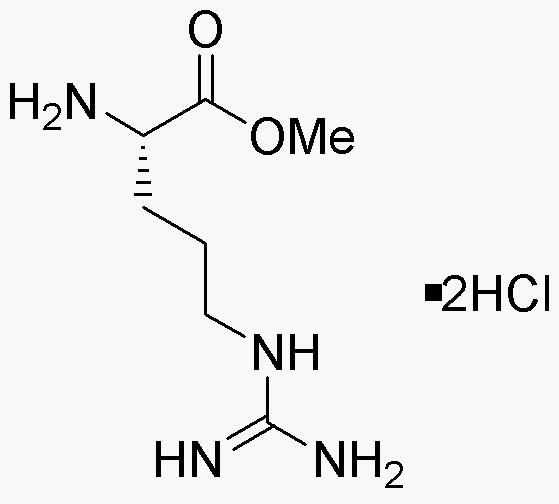L-Arginine methyl ester dihydrochloride is widely utilized in research focused on:
- Cardiovascular Health: This compound is often studied for its role in enhancing nitric oxide production, which can improve blood flow and reduce blood pressure, making it valuable in cardiovascular research.
- Sports Nutrition: Athletes and fitness enthusiasts use it as a supplement to potentially boost performance and recovery by increasing blood circulation and nutrient delivery to muscles.
- Wound Healing: Its application in dermatological studies shows promise in promoting wound healing due to its role in collagen synthesis and tissue repair.
- Neuroprotection: Research indicates that it may have neuroprotective effects, making it a candidate for studies related to brain health and neurodegenerative diseases.
- Pharmaceutical Development: The compound is explored in drug formulation for its potential to enhance the delivery of therapeutic agents, improving their efficacy and bioavailability.
General Information
Properties
Safety and Regulations
Applications
L-Arginine methyl ester dihydrochloride is widely utilized in research focused on:
- Cardiovascular Health: This compound is often studied for its role in enhancing nitric oxide production, which can improve blood flow and reduce blood pressure, making it valuable in cardiovascular research.
- Sports Nutrition: Athletes and fitness enthusiasts use it as a supplement to potentially boost performance and recovery by increasing blood circulation and nutrient delivery to muscles.
- Wound Healing: Its application in dermatological studies shows promise in promoting wound healing due to its role in collagen synthesis and tissue repair.
- Neuroprotection: Research indicates that it may have neuroprotective effects, making it a candidate for studies related to brain health and neurodegenerative diseases.
- Pharmaceutical Development: The compound is explored in drug formulation for its potential to enhance the delivery of therapeutic agents, improving their efficacy and bioavailability.
Documents
Safety Data Sheets (SDS)
The SDS provides comprehensive safety information on handling, storage, and disposal of the product.
Product Specification (PS)
The PS provides a comprehensive breakdown of the product’s properties, including chemical composition, physical state, purity, and storage requirements. It also details acceptable quality ranges and the product's intended applications.
Certificates of Analysis (COA)
Search for Certificates of Analysis (COA) by entering the products Lot Number. Lot and Batch Numbers can be found on a product’s label following the words ‘Lot’ or ‘Batch’.
*Catalog Number
*Lot Number
Certificates Of Origin (COO)
This COO confirms the country where the product was manufactured, and also details the materials and components used in it and whether it is derived from natural, synthetic, or other specific sources. This certificate may be required for customs, trade, and regulatory compliance.
*Catalog Number
*Lot Number
Safety Data Sheets (SDS)
The SDS provides comprehensive safety information on handling, storage, and disposal of the product.
DownloadProduct Specification (PS)
The PS provides a comprehensive breakdown of the product’s properties, including chemical composition, physical state, purity, and storage requirements. It also details acceptable quality ranges and the product's intended applications.
DownloadCertificates of Analysis (COA)
Search for Certificates of Analysis (COA) by entering the products Lot Number. Lot and Batch Numbers can be found on a product’s label following the words ‘Lot’ or ‘Batch’.
*Catalog Number
*Lot Number
Certificates Of Origin (COO)
This COO confirms the country where the product was manufactured, and also details the materials and components used in it and whether it is derived from natural, synthetic, or other specific sources. This certificate may be required for customs, trade, and regulatory compliance.


